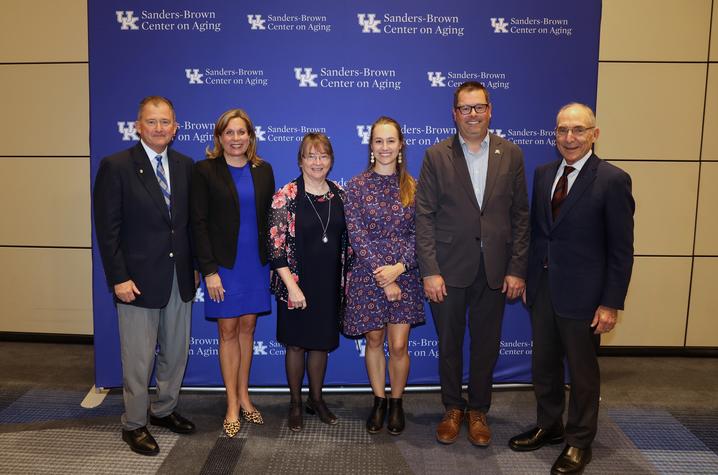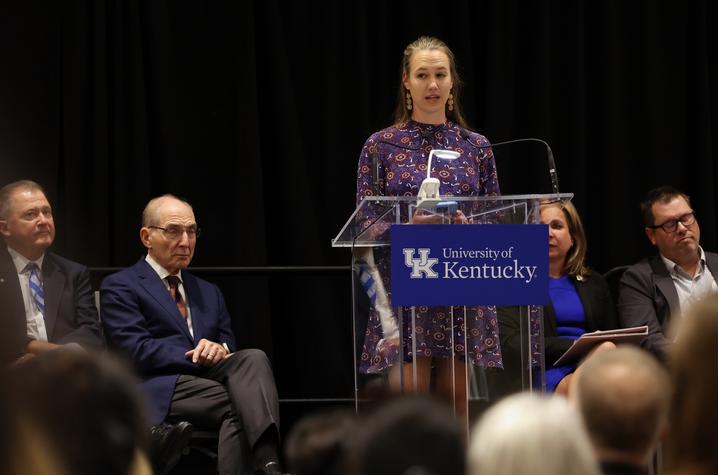UK Sanders-Brown Center on Aging celebrates 40 years as an NIH-funded Alzheimer’s Disease Center
Video produced by UK Research Communications. To view captions for this video, push play and click on the CC icon in the bottom right-hand corner of the screen. If using a mobile device, click on the gear icon in the same area.
LEXINGTON, Ky. (Oct. 15, 2025) — University of Kentucky leadership, along with state and community leaders, joined members of the Sanders-Brown Center on Aging to celebrate a significant achievement: 40 years of continuous funding from the National Institutes of Health (NIH) for their revolutionary work in the field of Alzheimer’s and dementia.
“For four decades, the Sanders-Brown Center on Aging has ensured that discoveries reach the people who need them most. The center shows us what it means to connect knowledge to humanity, and it reminds us that compassion is as essential to discovery as curiosity,” said University of Kentucky President Eli Capilouto. “As we look ahead, the work here will continue to shape what’s possible — through new technologies, deeper collaboration and a commitment to prevention as well as care.”
As a National Institute on Aging-designated Alzheimer’s Disease Research Center — one of just 37 ADRCs in the country — Sanders-Brown has played a crucial role in advancing scientific knowledge, improving patient care and fostering hope for millions of families affected by dementia.
“Congratulations to the entire Sanders-Brown team on four decades of excellence and impact. Throughout that time, Sanders-Brown has stood as a beacon of hope, for Kentucky and the world,” said Kentucky House Majority Floor Leader Steven Rudy. “As a nationally recognized leader in Alzheimer’s research and care, their groundbreaking work has transformed how we understand, detect and treat this devastating disease. The Kentucky House was proud to support the recent renovation of their state-of-the-art facilities, and we remain committed to investing in innovation that improves lives.”
“I am deeply proud that our flagship university and the Sanders-Brown Center on Aging benefit so many residents in Kentucky and especially many of my constituents in the 12th Senate District,” said Kentucky Sen. Amanda Mays Bledsoe. “The $28 million investment in their groundbreaking research represents so much more than bricks and mortar. This is an investment in hope for the more than 81,000 Kentuckians aged 65 and older living with Alzheimer’s disease. The work being done here also brings comfort and support to the countless families, friends and caregivers who walk alongside their loved ones every day in this fight.”
To earn this designation from the NIH, centers must demonstrate excellence in multiple areas of dementia research and care. Each ADRC must conduct cutting-edge, multidisciplinary studies into the causes, diagnosis, treatment and prevention of Alzheimer’s disease; maintain well-characterized groups of participants with and without memory disorders; and build core facilities that support scientific discovery — such as clinical, neuropathology, biomarker and data cores. Centers also must show strong collaboration across the national ADRC network, engage deeply with their surrounding communities and train the next generation of scientists and clinicians working to advance brain health.
These centers represent the flagship network of federally funded Alzheimer’s and dementia research programs in the U.S. Each institution is competitively renewed every five years based on scientific performance and impact — which underscores the remarkable achievement of Sanders-Brown maintaining continuous NIH funding for 40 years, making it one of only nine centers to do so.
“Now, more than ever, the work at Sanders-Brown will call on support from policymakers and partners, research scientists, teachers and scholars, communities and nonprofits — all of them working together with a shared vision and common goal: a better, stronger and healthier Kentucky,” said UK Board of Trustees Chair Britt Brockman. “The unrelenting excellence and work of a center like Sanders-Brown — in close collaboration with a network of partners and providers — is what it will take to turn aspiration and ambition into hope and healing.”
A legacy of discovery
“Sanders-Brown has truly been a national leader,” said Linda Van Eldik, Ph.D., director of the Sanders-Brown Center on Aging and its Alzheimer’s Disease Research Center. “From debunking early myths about what causes dementia to identifying new diseases that mimic Alzheimer’s, our scientists and clinicians have changed what the world knows about the aging brain.”
The University officially initiated its aging program in 1963 with the formation of a council on aging. In 1972, with support from philanthropists Col. Harland Sanders and future Gov. John Y. Brown Jr., funding was secured for construction of what became the Sanders-Brown Research Building. Additional support from Kentucky state government helped establish a new biomedical research program within the University of Kentucky Chandler Medical Center. In 1979, the center opened its doors and quickly emerged as a national leader in efforts to improve the quality of life for older adults through research and education.
Sanders-Brown first earned its ADRC designation in 1985 — one of the first 10 centers in the country to do so. That recognition placed UK among a select group of institutions dedicated to unraveling the mysteries of memory loss and developing new treatments for Alzheimer’s disease and related dementias. Today, the center is one of only nine in the nation to hold this prestigious NIH designation continuously for 40 years or more.
Sanders-Brown’s founding director, William Markesbery, M.D., laid out the groundwork for a center that would bridge basic science, clinical research and community outreach. “Dr. Markesbery realized that to understand Alzheimer’s disease, we also had to understand normal brain aging,” said Van Eldik. “His vision led to one of the first longitudinal brain aging studies in the world — and 40 years later, those same volunteers and their families continue to fuel our most impactful discoveries.”
Among those discoveries: Sanders-Brown researchers were among the first to disprove the once-popular “aluminum hypothesis” and later played a central role in identifying a new form of dementia called LATE — limbic-predominant age-related TDP-43 encephalopathy — which affects roughly one in five older adults. “That finding fundamentally changed how we understand memory disorders,” said Van Eldik. “It also ensures patients receive the right diagnosis and the right treatments moving forward.”
From the lab to the clinic — and back again
Greg Jicha, M.D., Ph.D., director of the ADRC Clinical Core, said the center’s success is rooted in its integration of research and care.
“The groundbreaking work starts in the lab, but it can’t stay there,” Jicha said. “At Sanders-Brown, discoveries are translated directly into better care for Kentuckians — new medicines, new diagnostic tools and new hope. And in turn, our patients’ experiences drive new lines of scientific inquiry. It’s truly a full circle of innovation.”
Jicha remembers that when the center first earned NIH funding in 1985, Alzheimer’s disease was virtually undiagnosable. “We didn’t have diagnostic criteria, let alone treatments,” he said. “Now we have drugs that can actually remove Alzheimer’s plaques from the brain — and UK played a major role in the research that made that possible.”
He added that the center’s leadership extends far beyond Kentucky’s borders.
“We’re the only Alzheimer’s Disease Center in Kentucky, and one of the key hubs for the southeastern U.S.,” Jicha said. “We collaborate across states and countries to drive this field forward.”
Stories of hope and renewed purpose
Over its four decades, Sanders-Brown has built an international reputation for world-class Alzheimer’s research, care and outreach — while also bringing understanding of dementia home to Kentucky.
Countless stories from Kentucky families serve as reminders as to why the work matters. They are stories similar to the one Mallory Martinez now shares in hopes of encouraging support for Sanders-Brown.
“It completely felt like the rug had been pulled out from under me,” Martinez said. The diagnosis her mother, Patti Pfiester, received came as a shock: “I really thought that was just an old person’s disease,” she said.
As Martinez and her family walked this new path, Sanders-Brown was with them every step of the way.
“It is a really special place,” Martinez shared. “We are lucky to have Sanders-Brown right here in Lexington.”
“When I see the faces of individuals that we are helping, it really touches my soul and makes me want to do as much as I can in my research to try to prevent this from happening to anyone else,” said Van Eldik.
Researchers at Sanders-Brown remain hopeful about the future — and grounded in the stories of people they serve.
“I think that when a cure or treatment for Alzheimer’s disease is developed, Sanders-Brown is going to be playing a role,” said Jicha.
Building the future of brain health
Today, Sanders-Brown continues to expand its reach, with more than 40 faculty, $28 million in active grants and a deep commitment to training the next generation of scientists. Its labs and clinical facilities — recently renovated to foster collaboration — bring together basic scientists, data experts, clinicians and community engagement teams under one roof.
“We’re passionate about training and mentoring the next generation of Alzheimer’s researchers,” Van Eldik said. “We have students, postdocs and residents working side by side with leading scientists. They are the future of this field — and they’re learning from some of the best right here in Kentucky.”
For Van Eldik, one goal remains clear: “I want every Kentuckian to know that we have a world-class Alzheimer’s research center right here in Lexington. Our discoveries are changing what’s possible in brain health — and they’re being made for the people of this Commonwealth.”


As the state’s flagship, land-grant institution, the University of Kentucky exists to advance the Commonwealth. We do that by preparing the next generation of leaders — placing students at the heart of everything we do — and transforming the lives of Kentuckians through education, research and creative work, service and health care. We pride ourselves on being a catalyst for breakthroughs and a force for healing, a place where ingenuity unfolds. It's all made possible by our people — visionaries, disruptors and pioneers — who make up 200 academic programs, a $476.5 million research and development enterprise and a world-class medical center, all on one campus.




